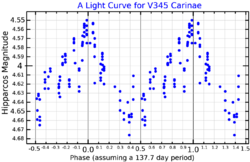Astronomy:V345 Carinae
| Observation data Equinox J2000.0]] (ICRS) | |
|---|---|
| Constellation | Carina |
| Right ascension | 09h 05m 38.37267s[2] |
| Declination | −70° 32′ 18.5832″[2] |
| Apparent magnitude (V) | +4.66[3] (4.67 to 4.78)[4] |
| Characteristics | |
| Spectral type | B2(IV)n[5] |
| B−V color index | −0.149±0.011[3] |
| Variable type | Be[6] |
| Astrometry | |
| Radial velocity (Rv) | +19.0±7.4[3] km/s |
| Proper motion (μ) | RA: −3.017[2] mas/yr Dec.: +8.394[2] mas/yr |
| Parallax (π) | 3.2440 ± 0.2602[2] mas |
| Distance | 1,010 ± 80 ly (310 ± 20 pc) |
| Absolute magnitude (MV) | −2.67[3] |
| Details | |
| Mass | 9.6±0.3[7] M☉ |
| Radius | 8.70±0.17[8] R☉ |
| Luminosity | 2,539.73[3] L☉ |
| Surface gravity (log g) | 3.80±0.04[8] cgs |
| Temperature | 19,000±190[8] K |
| Rotational velocity (v sin i) | 140±3[8] km/s |
| Age | 20.4±2.3[7] Myr |
| Other designations | |
| Database references | |
| SIMBAD | data |
V345 Carinae is a star in the constellation Carina. It has the Bayer designation E Carinae; V345 Carinae is the variable star designation. The star has a blue-white hue and is faintly visible to the naked eye with an apparent visual magnitude that fluctuates around +4.66.[3] Its actual brightness varies from magnitude +4.67 to +4.78 with a period of 137.7 days.[4] Based on parallax measurements, it is located at a distance of approximately 1,010 light years from the Sun.[2] It is drifting further away with a radial velocity of around +19 km/s.[3]
This star has a stellar classification of B2(IV)n,[5] matching a suspected B-type subgiant star. The 'n' notation indicates "nebulous" lines caused by rapid rotation: the star is spinning with a projected rotational velocity of 140 km/s.[8] It is a Be star having a circumstellar disk of hot, decreted gas that is inserting emission lines into the spectrum.[6] The star is 20[7] million years old with 9.6[7] times the mass of the Sun and 8.7[8] times the Sun's radius. It is radiating 2,540[3] times the luminosity of the Sun from its photosphere at an effective temperature of 19,000 K.[8]
The star displays a complex luminosity variation with a periods of 1.13028 and 137.7 days. Although thought to be a single star,[10] Carrier et al. (2002) suggested the longer period may be caused by some sort of binary interaction with the circumstellar disk or perhaps a light reflecting effect. However, no companion has been detected via radial velocity variations. This suggests that the companion would need to either have less than 1.7 times the mass of the Sun or it is being viewed from nearly pole-on.[11] The short-term variations may be from non-radial pulsations similar to those of ω CMa.[12]
References
- ↑ "Hipparcos Tools Interactive Data Access". ESA. https://www.cosmos.esa.int/web/hipparcos/interactive-data-access.
- ↑ 2.0 2.1 2.2 2.3 2.4 2.5 Brown, A. G. A. (August 2018). "Gaia Data Release 2: Summary of the contents and survey properties". Astronomy & Astrophysics 616: A1. doi:10.1051/0004-6361/201833051. Bibcode: 2018A&A...616A...1G. Gaia DR2 record for this source at VizieR.
- ↑ 3.0 3.1 3.2 3.3 3.4 3.5 3.6 3.7 Anderson, E.; Francis, Ch. (2012), "XHIP: An extended hipparcos compilation", Astronomy Letters 38 (5): 331, doi:10.1134/S1063773712050015, Bibcode: 2012AstL...38..331A.
- ↑ 4.0 4.1 V345 Carinae, https://www.aavso.org/vsx/index.php?view=detail.top&oid=6098, retrieved 2020-02-19.
- ↑ 5.0 5.1 Houk, Nancy; Cowley, A. P. (1979), Michigan catalogue of two-dimensional spectral types for the HD stars, 1, Ann Arbor, Michigan: Dept. of Astronomy, University of Michigan, Bibcode: 1978mcts.book.....H.
- ↑ 6.0 6.1 Samus, N. N. et al. (2017), "General Catalogue of Variable Stars", Astronomy Reports, 5.1 61 (1): 80–88, doi:10.1134/S1063772917010085, Bibcode: 2017ARep...61...80S.
- ↑ 7.0 7.1 7.2 7.3 Tetzlaff, N. et al. (January 2011), "A catalogue of young runaway Hipparcos stars within 3 kpc from the Sun", Monthly Notices of the Royal Astronomical Society 410 (1): 190–200, doi:10.1111/j.1365-2966.2010.17434.x, Bibcode: 2011MNRAS.410..190T.
- ↑ 8.0 8.1 8.2 8.3 8.4 8.5 8.6 Arcos, C. et al. (March 2018), "Stellar parameters and H α line profile variability of Be stars in the BeSOS survey", Monthly Notices of the Royal Astronomical Society 474 (4): 5287–5299, doi:10.1093/mnras/stx3075, Bibcode: 2018MNRAS.474.5287A.
- ↑ "E Car". SIMBAD. Centre de données astronomiques de Strasbourg. http://simbad.u-strasbg.fr/simbad/sim-basic?Ident=E+Car.
- ↑ Eggleton, P. P.; Tokovinin, A. A. (September 2008), "A catalogue of multiplicity among bright stellar systems", Monthly Notices of the Royal Astronomical Society 389 (2): 869–879, doi:10.1111/j.1365-2966.2008.13596.x, Bibcode: 2008MNRAS.389..869E.
- ↑ Carrier, F. et al. (April 2002), "Search for duplicity in periodic variable Be stars", Astronomy and Astrophysics 385 (2): 488–502, doi:10.1051/0004-6361:20020174, Bibcode: 2002A&A...385..488C.
- ↑ Rivinius, Th. et al. (November 2003), "Non-radially pulsating Be stars", Astronomy and Astrophysics 411 (2): 229–247, doi:10.1051/0004-6361:20031285, Bibcode: 2003A&A...411..229R.
 |


